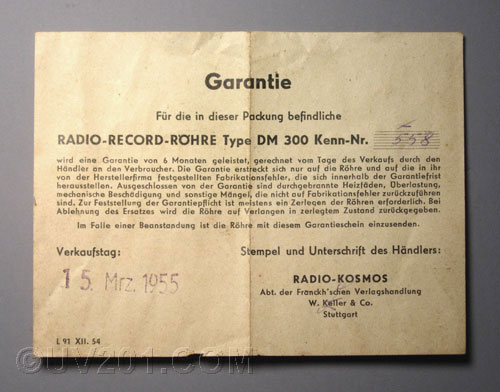| The Radio Technician Educational Kit (Kosmos Radiomann) |
 |
| This is an educational kit
from the mid-1950's. It was primarily meant
to teach elementary electronics to young boys. With the parts
provided, he could build a basic crystal set, a one-tube radio, or a
low-power transmitter, as well as perform a number of basic experiments involving electricity and magnetism. This is one of a long series of similar kits which were made in Germany and sold primarily in Europe, from the 1930's through the present time. They were sold under the Kosmos name, and were made in Stuttgart. The edition shown here is one that was marketed in Great Britain and (possibly) the United States, and has the cover and instruction book printed in English. The kit as shown here appears to be nearly complete, except for the instruction book, which is missing. This German website has a considerable amount of information about the Kosmos kits, if one cares to translate its content. Fortunately, it shows some of the illustrations from the instruction book. Pictured on the cover of the box is the regenerative radio. Interestingly, the picture shows the radio wired incorrectly. The two wires from the filament battery at the far right are both connected to the filament rheostat. Not only won't this work, it will destroy the battery quickly. Later versions corrected this problem. |
 |
 |
|
The radio shown here is the regenerative version that could be built with the kit. At the front is the tuning capacitor, which has a single rotor plate wedged between two stator plates (and two dielectric sheets). The two coils are wound on cardboard forms. The front coil (in the grid circuit) is fixed in position, while the rear coil (the feedback coil in the place circuit) can be rotated to adjust the coupling. The grid capacitor is formed from a thin piece of plastic with aluminum foil glued to each side. The filament rheostat consists of a length of resistance wire wound around a strip of cardboard. A conventional resistor is used for the grid leak, and a conventional capacitor is connected across the headphone. The entire circuit is held together by neat little binding posts and clamps machined out of brass, and the wood base is lacquered birch. So far, I have not gotten this radio to work satisfactorily, though it may not be wired correctly. The regeneration is very difficult to control, and I have only been able to receive one strong local station. The tube appears to be healthy, however. A single earphone was provided. A rubber strap was provided to hold it to the listener's ear. |
 |
 |
| The tube they provided with
the kit is the DM-300 type made by Radio-Record (see the warranty sheet,
below). This was a tetrode (two grid) type that was used in a
space-charge mode. This used one of the grids to accelerate the
electrons as they traveled from the filament to the plate, and allowed
the tube to operate at a very low plate voltage (13.5 volts, in this
case). As was typical of early German tubes, the elements are
oriented in a horizontal plane, unlike the vertical configuration common
in US-made tubes. The connection to the second grid is through a
binding post on the side of the tube's base. The original version of this tube was introduced in the late 20's. Apparently, they were used in these kits until the original stock was exhausted, and a new production run was undertaken in the 50's. This tube with this kit is from that later run. These tubes are said to be quite rare and in demand by collectors of these kits. |
 |